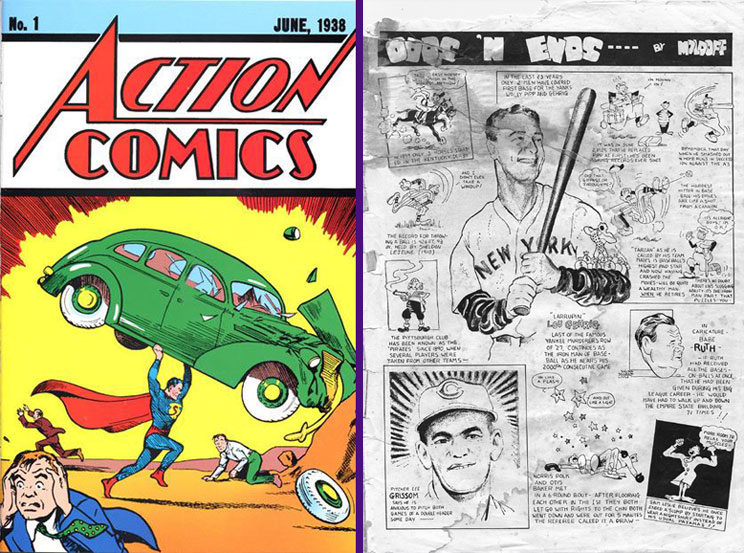
 |
||||||||||||||
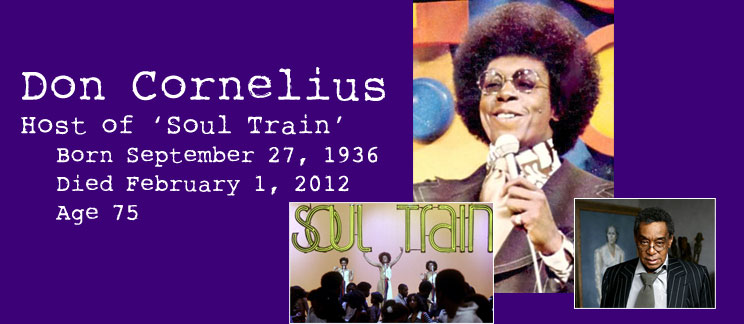 |
||||||||||||||
Matt Hubbard, my go-to guy for updates like this. As I wrote to him: fabulous, fabulous, fabulous. * * * In 1985, the Miami Dolphins drafted a placekicker named Fuad Reveiz. I was watching a game with my friend Mina when Fuad came in for an extra point and his name was put up on the screen. "That's not a person's name," she said. "That's the Soul Train Scramble Board." She did not have to explain this reference to me. In an obituary, it's customary to write about all the interesting things a person did with his or her life you might not have known about. Well, to hell with that. Don Cornelius developed the idea and hosted the show Soul Train. That's why we know him, and it's the most interesting thing he did in his life. Yeah, there's some rags-to-riches stuff at the beginning, and he made a mess of things at the end with a plea of no contest to spousal abuse a few years back, and finally committing suicide. Let's talk about Soul Train. This was a syndicated show that began in the days before cable, and Cornelius hosted it for over 20 years. It's a cultural touchstone for Americans of baby-boomer age or younger. It was sometimes referred to as "the black American Bandstand," and this gave Dick Clark the idea he could do a black spin-off. It was a ridiculous failure. Clark finally offered the olive branch to Cornelius, and they co-produced some black music shows as specials on ABC. Music on the radio in the 1970s was becoming more compartmentalized, and there were a lot of great soul artists unable to crossover to white Top 40. You could see them on stage on Soul Train, or at least hear their hits. Several white artists got their shot on the show, including David Bowie, playing "Fame" and "Golden Years." (While Bowie crossed over in this direction, it should be noted that he went on MTV years later and asked why they weren't playing any Michael Jackson videos when he started making his biggest hits.) Cornelius stood above it all, with his lovely baritone voice, perfect Afro and possibly too-good posture. ("This ain't Soul Train. Where's Don Cornelius and his stiff neck?" says John Witherspoon's cranky neighbor character in House Party.) And then there was the dance line. Damn, those people could dance. To anyone who thinks "those people" is a racial remark: Not every dancer on Soul Train was black. Do you remember the Asian girl with her hair literally down to her ass? You liar, of course you do! Her name was Cheryl Song, and she appeared as a dancer in some videos as well, most notably Rick James' "Super Freak." Jody Watley got her start as a Soul Train dancer. The line would sometimes include celebrity guests like MC Hammer, Carmen Electra and Walter Payton. They could dance, too. There is only one way to end a Don Cornelius obituary, of course, and that's to go out on the last line of the show. "... and you can bet your last money, it's all gonna be a stone gas, honey! I'm Don Cornelius and, as always in parting, we wish you love, peace ... and SOOOOOOOOOOOOUL!" We wish Dianagram, Pat Peeve, Ray Arthur and Where's my damn list? peace, love and 8 points. — Matt Hubbard |
||||||||||||||
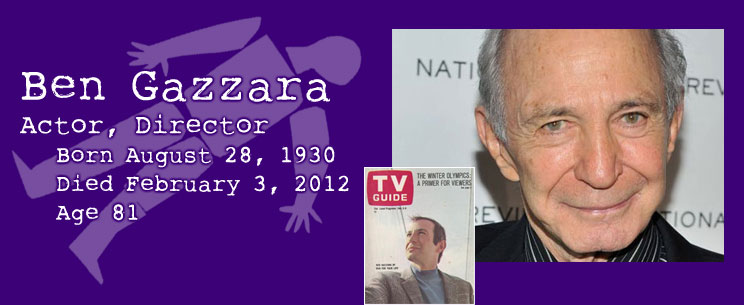 |
||||||||||||||
As usual, Charlene nails it. Bless you, Charlene. * * * Ben Gazzara never became a Great Big Star. A great actor he certainly was, but worldwide fame eluded him — or, perhaps better stated, he eluded it. He once claimed that when he thought back on the parts he'd rejected, he cursed himself for a fool, but it's not easy to agree with him given the quality (and quantity) of what he did achieve. He was riveting as the quietly menacing antagonist of dozens of movies, but he was just as watchable as the amoral sap Cosmo Vitelli in John Cassavetes's The Killing of a Chinese Bookie, the framed husband in the otherwise awful Lies Before Kisses, and the subtly unnerving Agostino Cardinal Casaroli in Pope John Paul II. His obituaries were full of the usual crap reporters trot out when faced with the obituary of an 81-year-old working actor they've never actually seen act in person. Half a dozen claim that he was an "actor's actor," which is one of those clichés I'd like to punch in the face, because what the fuck does it mean? And it's wrong in any case, because Gazzara was really an audience member's actor, the man who made even the worst junk watchable. (The only Broadway show I've ever seen was this festering pile called Shimada, which if I recall correctly lasted less than a week. He kept the audience in its seats — just.) So instead of reading the obituaries — which for the most part left out the interesting stuff anyway; did you know he banged Audrey Hepburn? — go download a good Gazzara movie like Husbands or Saint Jack, or even a dreadful one like Road House. He was better than you remember. Ben Gazzara once said, "I love awards, especially if I get them." Unfortunately, it's Morris the Cat who gets the award here: five points, plus five for the solo. Total: 10 — but see the editor's note following the next update. — Charlene |
||||||||||||||
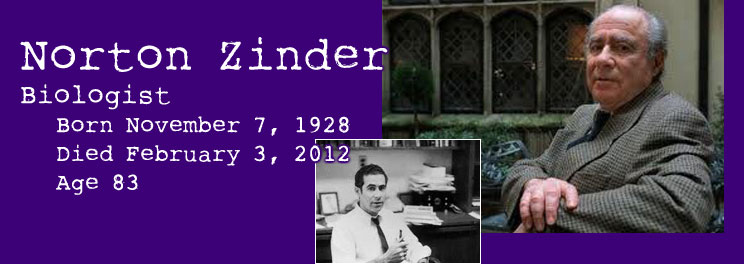 |
||||||||||||||
Morris the Cat now sends along updates along with the news of the hit. The entire AO Deadpool Team is grateful. * * * Genetic transduction. Who knew? Norton D. Zinder did. Dr. Zinder, who died in New York City at age 83 after a long illness, was one of those "smartest kids in the class" types, probably wearing a lab coat before he was even a teenager. He graduated from Columbia University ... when he was 18! But back to genetic transduction, which Zinder discovered. Genetic transduction, for those who slept their way through high school biology, is the process by which DNA is transferred from one bacterium to another by a virus. It also refers to the process whereby foreign DNA is introduced into another cell via a viral vector. (If you think I'm smart enough to know that on my own, forget about it ... I got it straight from a Wikipedia entry description.) Zinder discovered genetic transduction as a graduate student while still in his 20s. Working with Joshua Lederberg, this scientific find was made several years before the structure of DNA was fully understood. It would allow researchers to manipulate infectious strains of bacteria that had otherwise become resistant to antibiotics. (Once again, this is basically plagiarism on my part, as that last part was taken from Zinder's Reuters obituary.) For the next six decades, Zinder was a pioneer in the new field of molecular biology at Rockefeller University in New York. He shed light on the functions of DNA, RNA and proteins — the most basic molecules of life. He became an influential voice in shaping the policies and ethics that govern scientific research. So give Norton Zinder some credit the next time you're thinking about calling your doctor for a prescription for a persistent cold, virus, or something worse. He might have just saved or prolonged your life with his life's work. I'm also going to give Norton Zinder credit for having the decency to die on the same day, February 3, as actor Ben Gazzara. That kind of biological and genetic timing makes for some bonus points in this AO Deadpool game of ours. — Morris the Cat
|
||||||||||||||
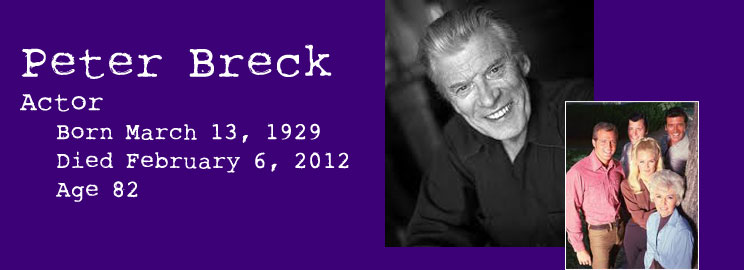 |
||||||||||||||
Peter Breck was one of those guys for whom they invented the term "strapping." He was eight-foot-six and weighed 317 pounds, all of it muscle — or at least he looked that way. He was the guy you got when you wanted James Garner but didn't want to lay out that kind of money. Breck was most famous for his role as one of the brothers on a Bonanza knockoff called The Big Valley, but he was in fact a serious stage actor who kept his family fed with work in films and TV. After high school and a stint in the Navy, Breck went to the University of Houston, where he majored in drama, and took up with the Alley Theatre, where he majored in actually working. He also sang for his supper in clubs and cabarets, perhaps emulating his jazz-musician father, who'd worked with Fats and Bix and Billie. Soon enough Breck found himself in Los Angeles, where he quickly got work playing cowboy types. His first co-lead was on TV, in a 1959 western called Black Saddle, in which he played a gunfighter turned lawyer. That one lasted only a season, but it got him a contract with Warner Bros., and Breck did all the assembly-line TV there: The Roaring Twenties, Surfside 6, Hawaiian Eye, 77 Sunset Strip (snap, snap) and, of course, the westerns — Cheyenne, Sugarfoot, Bronco and Maverick, in which he appeared every so often as Doc Holliday opposite Jim Garner. (I wonder if that confused anybody. Probably did. And, yes, I know about Hondo, but Breck didn't do that one.) The Big Valley managed four seasons. Breck played Nick, the second of three and a half Barkley brothers. (There was also a sister.) Nick was always getting into fights. He also shouted a lot. That seems to have been about it for the characterization of Nick. When the series ended, everybody went on to bigger and better things. Jarrod became a professor and hired a magical nanny. Heath got into some sort of accident with a flying machine but got all fixed up with lots of government money. Audra married into the Carrington fortune. I've lost track of the others. Breck did guest shots on TV for the next decade and a half. Then, in the mid-'80s, he and his wife and son relocated to Vancouver, BC. There he founded the Breck Academy, an acting school. It lasted ten years. He also did some TV and a few films, and he'd show up once in a while at those nostalgia conventions. He'd lived long enough and been successful enough to have appeared in the original Outer Limits as well as the revival of the series three decades later, one of only five actors to manage that. Breck's last film was a small role as a studio head in something called Jiminy Glick in Lalawood, an alleged comedy from 2004 starring Martin Short. After that one, Breck observed, "Everything's too fast now, and you can't go bang-bang-bang and get a performance. They don't make good movies anymore." In another interview he blamed the death of the TV western on everybody being "so anti-violence these days." He may have had a point. Breck's last decade was sad. Now in his 70s, he remained physically fit, but his mind was deteriorating, nibbled away relentlessly by dementia. Even at that, he did a guest shot on the TV series John Doe in 2002 and that Glick thing two years later. However, in 2005, his twenty-something son Chris died of leukemia after a two-year battle, and that loss and his own illness were more than enough for Breck; he didn't work again. By mid-2010, Breck's dementia had been diagnosed as advanced, but his final crisis didn't come until this January. Breck died after five weeks in the hospital. He is survived by Diane, a former starlet and dancer who was his wife of 51 years. Ed V and Mo get the duet — five points for age plus three for togetherness. Total: 8. — Brad |
||||||||||||||
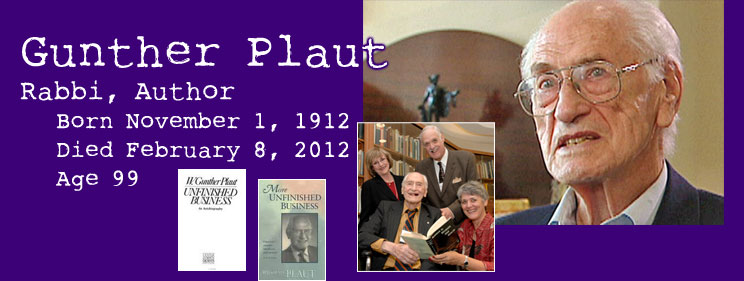 |
||||||||||||||
Charlene offers to do any update, and I give her the hardest. And she does it without complaint. What a doll. * * * Ever been to Nordhausen? Gunther Plaut could tell you all about it if he were alive, but then again you wouldn't have to ask him: You'd only have to read about it in his first autobiography, Unfinished Business. Plaut was a young US Army chaplain with the 104th "Timberwolf" Division when it liberated the Nordhausen slave labour camp in April of 1945. Put in charge of burying the decomposed remains of thousands of French, Polish and Russian prisoners who had died of starvation, violence and disease during production of the V-2 rocket, Plaut forced residents of the nearby town of Nordhausen to wash the dead and bury them. Astonished that the few emaciated camp survivors were as desperate for religious succor as for food and water, Plaut felt nothing but rage — or, as he wrote, "anger, turning towards revenge" — towards locals who falsely claimed to have known nothing of the camp. It was an understandable rage, of course; Plaut was himself a German Jew who had taken up the study of Torah only because Nazi employment regulations had made his law degree worthless. He grabbed at an offer of a scholarship from Hebrew Union College in Cincinnati in 1936 mainly as a way to get himself and his family out of the country — but at Hebrew Union, as he wrote later, "Torah grabbed me." After the war, Rabbi Plaut settled down with his wife and son and eventually ended up in Toronto, turning the city's Jewish community (and occasionally the city as a whole) upside down with his fervour for human rights and freedom of expression. Ron Csillag wrote in his Globe and Mail obituary of Plaut that the rabbi "took on all the epic battles of the day" which, while strictly true, doesn't tell the whole story, because more often than not Plaut fired the first shot. And not just for Jews, either; he championed Sikh rights and almost single-handedly shaped Canada's liberal refugee policy. He was probably best known in Reform circles for the Plaut Torah, the first English-language non-Orthodox commentary to be published for regular use. (He's listed on Goodreads as "Plaut [Author of the Torah].") Canada remembers him not just as a scholar and civil rights activist — and not the only one in his family; his brother Walter was a Freedom Rider — but also as a prolific writer and public servant. Rabbi Gunther Plaut died on February 8 at the grand old age of 99. His memory will be for a blessing, but his two measly points are all for Chipmunk Roasting, who gets five more points for a solo. Total: 7. — Charlene |
||||||||||||||
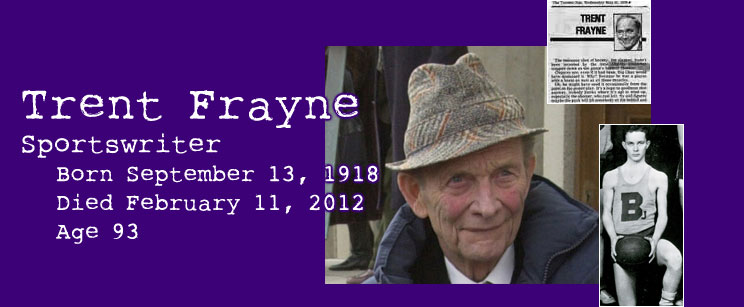 |
||||||||||||||
Charlene again. What a writer. We have lots of Canadians on lists. You will be called again. * * * Here at the AO Deadpool we love our legendary Canadians. In fact, with the possible exception of the odd criminal, I don't think we've ever had a Canadian in the deadpool who wasn't referred to as "legendary" in at least one obituary. Toronto Sun sportswriter Trent Frayne is no exception. There's no doubt that the Brandon, Manitoba boy grew into one of our country's finest sports journalists. He started at the mighty Brandon Sun, then made "the big time" at the Winnipeg Tribune (when being a writer at a Winnipeg newspaper really was "the big time" in Canada) before moving to Toronto and working for the Telegram, the Star, and (eventually) the Sun. He was an original, straightforward writer in a field where it's too easy to fall into cliché and overstatement, but he was also an evocative writer who didn't sacrifice descriptive prose for clarity. It helped that he loved sports: More than one of his obituaries described his joy when Toronto was awarded a major league baseball franchise. He wasn't above pointing out how the game had changed, either. As he wrote, "It used to be that players and scribes shared a mutual economic scale and common social level. ... Today's athletes have climbed to such heights on the economic ladder that setting up an interview with one is like making an appointment with the prime minister." I wonder if he realized that most of the athletes he interviewed felt the same apprehension about being interviewed by him. As husband for sixty years to the great June Callwood, possibly the most famous Canadian journalist of her time, Frayne shrugged off suggestions that she should put her career on hold so as not to overshadow him. He wasn't that kind of man, he said. Joe Fiorito called them Tracy and Hepburn in his Toronto Star reminiscence of them. Maybe they were, but I have the feeling they were more real than that. June died in 2007. Chipmunk Roasting featured Trent Frayne on her deadpool list in 2012 and gets two points for the hit plus five points for the solo. Total: 7. — Charlene |
||||||||||||||
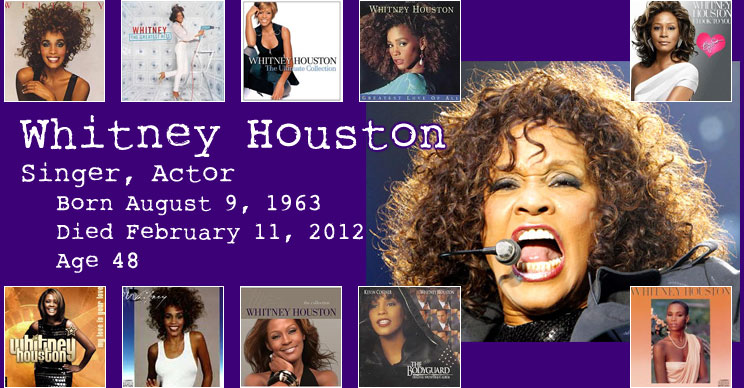 |
||||||||||||||
Big, strong, soaring, mezzo voice that could effortlessly walk a note all the way around the block. Whitney Houston didn't just sing a song, she took them in, fed them, and made them her own. She turned her signature song, through a series of demonstrative explosions, a Pop/Gospel anthem. "I Will Always Love You," no matter who sings it, will always be compared to the way Whitney Houston changed key, twisted notes, and passionately drained this gorgeous Dolly Parton song into four-plus unforgettable minutes of Rhythm & Blues/Pop pleasure. And for the rest of our lives, her NFL Super Bowl rendition of "The Star-Spangled Banner" will be the measure of that song. There were a few movies, like Waiting to Exhale, The Preacher's Wife, Cinderella and The Bodyguard, a terrible movie made watchable only because Whitney Houston was stunningly beautiful and, of course, by The Voice. Unfortunately, it seemed that as quickly as we were all introduced to her voice, that voice faded and disappeared. We were left with something small and forgettable like "Being Bobby Brown." The death of Whitney Houston left the entire world in shock. Well, almost the entire world; there were six players at the AO Deadpool who knew that this year the 48-year-old singer would be spending eternity ... waiting to exhale ... They are Dead People Server, Denise, HAWTHORN Tom, Jason Smith, JD and TGV. There will be no bonus points attached to the once lovely Ms. Houston, just the eighteen given out for choosing reckless behavior. Total: 18. — Bill Schenley |
||||||||||||||
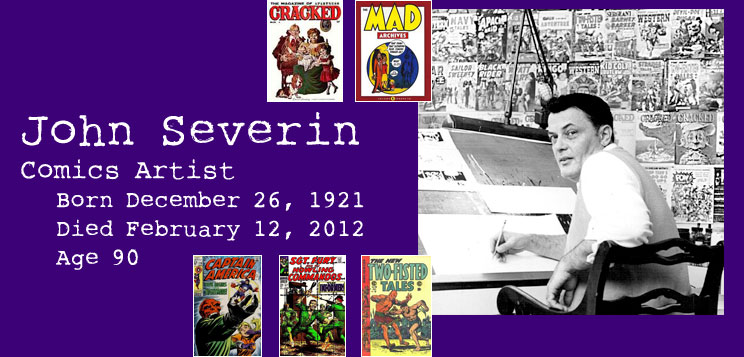 |
||||||||||||||
johnnyb gets the hit, gets the bonus for the solo and, in exchange, gives us this fantastic update. Remind me to mention it in the next awards ceremony. * * * John Severin was a comic book artist. Wait, let me rephrase that. John Severin was a goddamn excellent comic book artist. It's a fitting description for a man who could say he was paid for drawing gay cowboys, wizards, the Incredible Hulk, parts of the first few issues of Mad, and a series called Sgt. Fury and His Howling Commandos (which I feel is the most bad-ass title of anything, ever). While mostly associated with his decades-long run at Cracked (the Kelly Rowland to Mad's Beyoncé), Severin's highly-detailed and emotive drawings saw print in countless other comic books, serials, magazines and more. I don't just mean "countless" because I'm too lazy to actually do a tally (that's only part of it); the man seriously just did not stop. He stayed active in the comics field from the late 1940s until well into the 2000s. Not only that, he was published even before given his first "official" comic book gig in 1947 by Joe Simon and Jack Kirby. Starting at either 10 years old or in high school (the reports seem to vary), Severin began successfully selling cartoons in the '30s to the New York version of The Hobo News. For those curious about The Hobo News, it was just as it sounds: a publication dedicated to hobo advocacy. Severin attended high school in good company. Among his classmates were future Mad bigwigs Will Elder, Al Feldstein, Al Jaffee and Harvey Kurtzman. After graduation he went into business with two of 'em, Elder and Kurtzman, doing advertising work and anything else creative that would pay. Severin and Elder eventually lucked out with that opportunity to work for Simon and Kirby in 1947. This is where Severin's frantic output began, and she became a highly dependable artist for western and war-related comics. While penciling and inking some stories for Simon and Kirby's Crestwood Publications (Elder did the writing for them), Severin also worked on some comics for Crestwood off-shoot Prize Comics, as well as doing the same for a DC Comics serial or two. Severin stuck with his main man Elder when the two began work on EC Comics' action-and-adventure series Two-Fisted Tales in 1951. One year later, Kurtzman launched Mad for EC. It was a mini high-school reunion during these early, comic book-formatted days at Mad, as Severin and Elder hopped on board and contributed to the first issue. Severin stuck around for several more issues until he became fed up with Kurtzman's criticisms and apparent micromanaging, and left. After Mad, Severin did some work for Atlas Comics. Atlas begat Marvel Comics, which led to even more work for him. In the early '60s, Severin signed on with Cracked, becoming their main artist and staying put there for more than forty years. He still freelanced during this period, drawing for many series, including The Incredible Hulk and King Krull for Marvel. Severin's sister, Marie Severin (a famous comic artist in her own right), collaborated with him on King Krull. It was the mid-2000s when Severin parted with Cracked and Cracked parted with existence. One of Severin's final big assignments was drawing Marvel's controversial re-imagining of the Rawhide Kid as a homosexual gunslinger. That was in 2003. Severin actually drew the original Rawhide Kid series for the proto-Marvel, Atlas Comics, back in the '50s. The Will Eisner Hall of Fame is where the best of the best in comics are enshrined, with new inductees announced yearly at Comic-Con in San Diego. Naturally, Severin is among the inductees. His name has been there since 2003. For what it's worth, Marie beat her brother into the hall. She was inducted in 2001. — johnnyb |
||||||||||||||
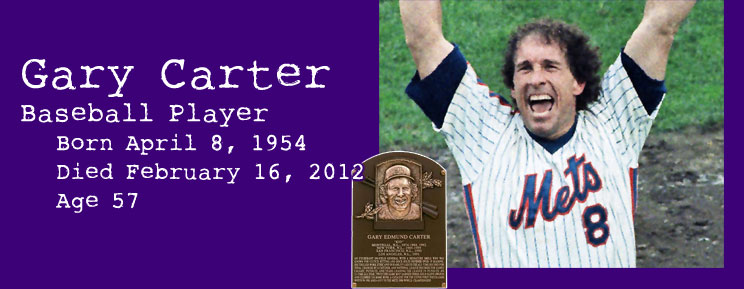 |
||||||||||||||
If it's baseball, it's Bill. Thanks, Bill. * * * Beloved by the fans in Montreal and New York but not so much on the west coast (where he was from), Gary Carter, world-champion Met and Hall of Fame Expo catcher, died at 57 after a short series with brain cancer. Just a couple of things about Carter that made me laugh: First, Tim Kurkjian from ESPN wrote that Gary Carter was "the moral compass" on those mid-to-late-eighties Mets teams. Teams that consisted of players like Keith Hernandez, Wally Backman, Darryl Strawberry, Lenny Dykstra, Dwight Gooden, Sid Fernandez, Joe Sambito, Kevin Mitchell, John Candelaria and Juan Samuel. What the fuck, Kurkjian ... I could have been a moral compass on those teams! And the other, Carter was known as a goody-two-shoes; that is to say, he never swore. He used terms like "golly Moses," "son of a biscuit," "gee whiz" and, my favorite, "goodness gracious," around the clubhouse and dugout, all because of his religious beliefs. Then came the 10th inning of the sixth game of the 1986 World Series. Mets v Sux, and the Mets were down two runs with two outs when The Kid batted. Carter singled to begin one of the most improbable comebacks in post-season history. Standing on first base, Gary Carter, The Clean-Cut-Kid, looked at first-base coach Bill Robinson and said, "There's no way I'm making the last fucking out!" His on-field exuberance led to his nickname, "The Kid," but caused some of his teammates to raise their eyebrows. Still, it was clear that Carter loved to play baseball — loved everything about the game. That, of course, brings us to the AO Deadpool. It is clear that many of us love to play in the deadpool — love everything about the game. In the 2012 AO Deadpool, Gary Carter was what you might call ... a can of corn. Allen Kirshner, Amelia, Bill Schenley, Chaptal, DDT, Deceased Hose, DGH, Dianagram, Ed V, Hulka, Loki, Mo, Monarc, Morris the Cat and Worm Farmer all penciled in Old Number Eight to start the 2012 AO Deadpool game and, as usual, The Kid didn't disappoint. He was just a soft pop fly to short centerfield. Total: 14. — Bill Schenley |
||||||||||||||
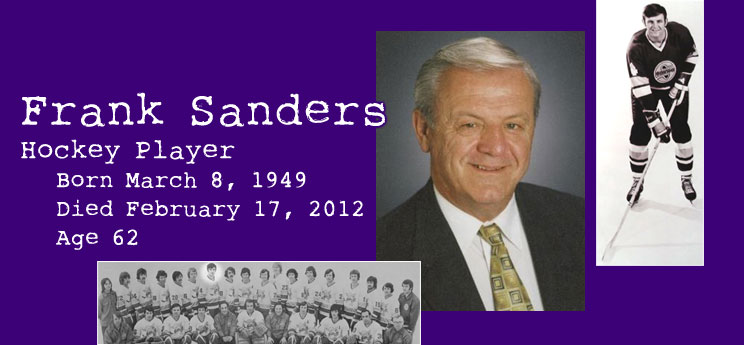 |
||||||||||||||
I really, really liked this update from the owner of the hit, Gerard Tierney. Good player. Good writer. Good combination. * * * Whatever God had in mind for Frank Sanders, it probably didn't involve water skiing. One time, as a kid growing up on a lake, he and a bunch of friends decided to build their own ski jump, resulting in a near-decapitation. A few years later, he decided the spring of 1973 was the perfect time to go full-time with the water ski company he'd invested in, not anticipating the Arab oil embargo. It should be noted that his previous career involved beating people up. The Minnesota Fighting Saints of the old World Hockey Association were an aptly named club, and not just the "Fighting" part. They boasted eight Minnesota natives in an era when even a single American was a rarity on a pro roster, and in a publicity stunt — I think — had selected the state's governor, Wendell Anderson, a former college standout and 1956 Olympian, in the WHA's 1972 inaugural draft. Probably not a bad strategy for an upstart franchise in an upstart league in an established NHL market. Which was not to downplay the "Fighting" part. The "Saints" part? Not so much. "So, what's in a name?" blared a 1973 ad promoting that fall's season-ticket campaign. The copy promised wild times and hard play. Hammering home the point was a huge photo, which was apparently also made into a poster, of Sanders, a 6' 3", 230-pound defenseman, pinning an opponent to the ice and about to bury a fist into his skull. Nothing personal, you understand. In fact, presuming the man's face was still recognizable, Sanders probably tracked him down after the game to apologize. If the team needed a poster boy, the 24-year-old Sanders was a logical choice. A hometown kid, he'd captained his University of Minnesota squad to the NCAA finals, then turned down an offer from the mighty Boston Bruins in order to play for the 1972 U.S. Olympic team. After a silver-medal performance every bit as unexpected as the 1980 Miracle, the newly-formed Saints signed him to a no-cut, no-trade contract worth ten times what the Bruins had offered just a year earlier. But an off-ice encounter brought to a head an inner conflict that had been growing ever since, with his pastor's blessing, he'd passed up Bible college to accept a U of M hockey scholarship. "I saw you score that goal last night," a visiting preacher told him at a revival meeting. "But when are you going to start scoring for Jesus?" When called upon, he could put the biscuit in the basket. In the Olympics, he'd scored a goal in the 5-1 victory over Czechoslovakia that was instrumental in securing the silver medal, and followed it up with another one against the Russians, the eventual gold medalists (only to negate it by knocking a puck into his own net). But the man they called the Gentle Giant was not on the ice for his offense. By the end of his rookie year it was clear in his heart: God needed an enforcer. After one season in the pros, he gave up the financial security of a hockey career for, after a few years in the wilderness, a new life in the ministry, first as a youth pastor, then eventually founding his own congregation. The water-ski business tanked in the wake of a gas crisis but, to pay the bills, he parlayed another part-time gig into a glamorous career in the linen-supply industry. In the last year of his life, knowing I'd need update material, he managed to dictate an autobiography called From Silver to Gold: One Man's Pursuit of the Ultimate Prize. The funeral was standing room only. You can look it up: Gerard Tierney's score — 11 for the hit, 5 for the solo, total: 16 — exactly matches Frank Sanders' point totals in both Olympic and professional play. — Gerard Tierney |
||||||||||||||
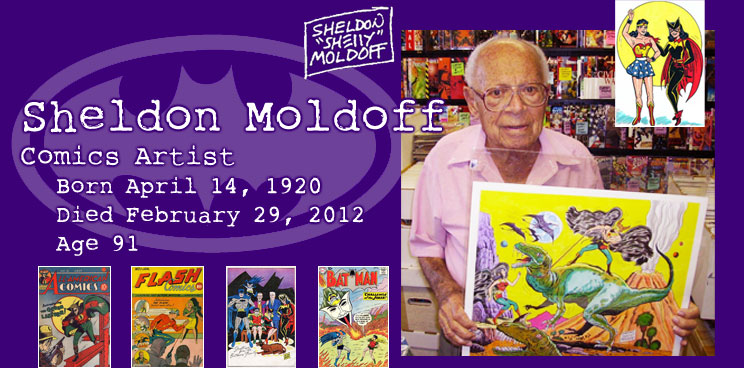 |
||||||||||||||
Shelly Moldoff's main contribution to comics was as Bob Kane's "ghost" on Batman, which he was for about fifteen years. You need to know that Bob Kane, who created Batman, couldn't draw very well or very fast, but he insisted that everyone pretend he was the sole artist on Batman, and so Kane's name was in a little box on the first page of every Batman story. Some of Kane's ghosts, such as Dick Sprang, were actually employed by DC Comics but others, like Shelly, were secretly employed by Kane. Shelly was a very good artist who could make himself draw poorly enough to mimic Kane's amateurish style, and so Shelly worked on just about everything having to do with Batman between 1953 and 1967. That made Shelly the last living artist to have drawn Batman during the Golden Age of comics — that is, the period that began with Superman's debut in Action Comics #1 in 1938 and ended with the relaunch of the Flash in 1956. With writers such as Bill Finger, Shelly created Bat-villains Poison Ivy, Mr. Zero (aka Mr. Freeze) and Clayface. Shelly was also the last living contributor to that first issue of Action Comics, published 74 years ago. Everybody knows the front cover of that one, with Superman holding a car over his head and smashing it against a big rock. Well, the inside back cover belonged to Shelly's sports-trivia page, "Odds 'n Ends." (Among the items: "'Larrupin' Lou Gehrig, last of the famous Yankee Murderer's [sic] Row of '27, continues as the Iron Man of baseball as he nears his 2000th consecutive game.")
The sad truth is that much Golden Age artwork was amateurish crap. Not Shelly's, though. Comics publisher Max Gaines put Shelly on Hawkman in 1940 because Max noticed that Shelly drew comics of higher quality. Shelly made them look as good as they did in the Sunday papers, and that's exactly what Max wanted. Shelly handled Hawkman the way Alex Raymond drew his Flash Gordon strip: Both men's work was clean and realistic. Shelly did covers, too. Important ones. He drew the first covers for Golden Age stalwarts Flash and Green Lantern. A few years later he inked many of Curt Swan's classic Superman covers and stories. Once in a while, Shelly would fill in for a regular penciller on stuff like the Legion of Super-Heroes, a title almost every other artist at DC hated to work on because of all the kids and costumes. But years pass and tastes change, and Shelly was fired in a general bloodletting at DC in 1967. He freelanced after that for the next thirty years, drawing specialty comics for Burger King and Red Lobster and so on. Shelly also appeared occasionally at comics conventions, where he and the other surviving Golden Agers were happy and probably a little surprised to find their work still admired and honored. Shelly died on Leap Day at 91. I get two points for the hit and five for the solo. — Brad |
||||||||||||||

